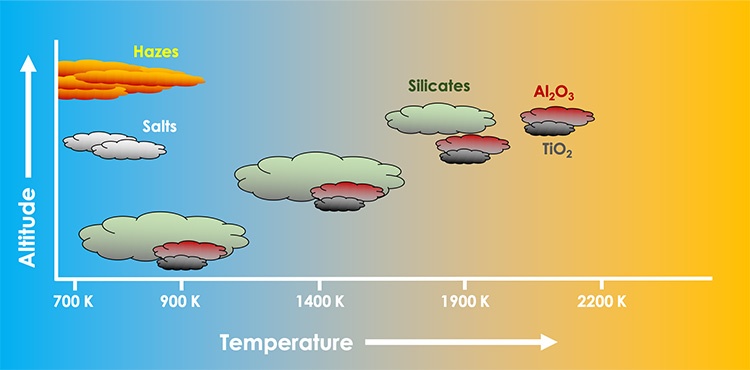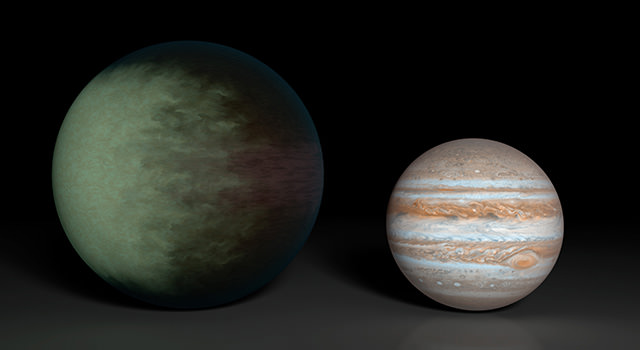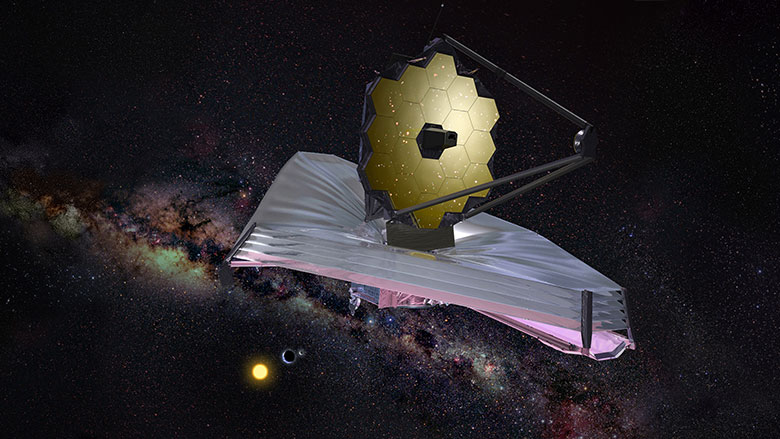Thanks to the success of the Kepler mission, we know that there are multitudes of exoplanets of a type called “Hot Jupiters.” These are gas giants that orbit so close to their stars that they reach extremely high temperatures. They also have exotic atmospheres, and those atmospheres contain a lot of strangeness, like clouds made of aluminum oxide, and titanium rain.
A team of astronomers has created a cloud atlas for Hot Jupiters, detailing which type of clouds and atmospheres we’ll see when we observe different Hot Jupiters.
Though all Hot Jupiters are similar, they do display some differences. And those differences can dictate what we’ll see in their atmospheres, especially over the next few years, as we develop more powerful telescopes to observe them with.
“The kinds of clouds that can exist in these hot atmospheres are things that we don’t really think of as clouds in the solar system.”
Peter Gao, Lead Author, U of C Berkeley
The upper mass limit for a Hot Jupiter is about 13.6 Jupiter masses. Above that, it would fuse deuterium, and would be a brown dwarf. Their orbital period is between 1.2 and 111 Earth days, and the orbits are nearly circular, with low eccentricity. Many Hot Jupiters have low densities, and they’re tidally locked to their star. They’re rare around red dwarf stars, common around F and G-type stars, and less common around K-type stars.
One reason we know of so many Hot Jupiters is because they’re so easy to detect. When they transit in front of their stars, they block much more light than smaller planets. And since their orbital periods are so short, the chances of catching one transiting while we’re watching is quite high.
Since Hot Jupiters are so easily found, and are excellent candidates for atmospheric observation with future telescopes, a team of astronomers put together a cloud atlas for them. This atlas is basically a model of the different types of atmospheres and clouds to be found on different Hot Jupiters.

The team of astronomers is from Canada, the UK, and the USA. Lead author is Peter Gao, a postdoctoral fellow at the University of California, Berkeley. The title of the paper is “Aerosol composition of hot giant exoplanets dominated by silicates and hydrocarbon hazes.” It’s published in the journal Nature Astronomy.
The idea behind the study is to catalog the type of atmospheres that Hot Jupiters have. As the authors write in the study, “Aerosols are common in the atmospheres of exoplanets across a wide swath of temperatures, masses and ages. These aerosols strongly impact observations of transmitted, reflected and emitted light from exoplanets, obfuscating our understanding of exoplanet thermal structure and composition.”
Understanding the aerosols in Hot Jupiter atmospheres will give astronomers a leg up when observing those atmospheres in the future. “Knowing the dominant aerosol composition would facilitate interpretations of exoplanet observations and theoretical understanding of their atmospheres,” they write. Their work is also relevant to worlds in our own Solar System, like the cooler gas giants Jupiter, Saturn, Uranus, and Neptune, and moons like Titan, which is dominated by a thick, hazy atmosphere.

According to the authors, one type of cloud dominates the atmospheres of gias giants, whether they’re Hot Jupiters or cooler giants. That atmosphere contains “liquid or solid droplets of silicon and oxygen, like melted quartz or molten sand.”
“The kinds of clouds that can exist in these hot atmospheres are things that we don’t really think of as clouds in the solar system,” said lead author Peter Gao in a press release. “There have been models that predict various compositions, but the point of this study was to assess which of these compositions actually matter and compare the model to the available data that we have.”
Exoplanet atmospheres—and really anything to do with exoplanets—is a hot topic in astronomy now, and has been for about a decade. Astronomers have been able to look at those atmospheres as starlight passes through them and determine some facts about their composition.
In 2019, for example, scientists found water vapour—maybe even rain—in the atmosphere of one exoplanet. In 2020 researchers discovered evidence of molten iron rain in the atmosphere on the nightside of a tidally-locked exoplanet. And in October 2013, astronomers found evidence of cloud cover on one of the first exoplanets discovered by the Kepler spacecraft, Kepler 7b.

But for every exoplanet that offers up its atmospheric secrets to spectroscopy, there’s another whose cloud cover is so thick that spectroscopy doesn’t work. There’s so much cloud that starlight won’t pass through it at all. This prevents astronomers from examining the deeper layers of the atmosphere, where clues about the planet are hidden.
“We have found a lot of clouds: some kinds of particles — not molecules, but small droplets — that are hanging out in these atmospheres,” Gao said. “We don’t really know what they are made of, but they are contaminating our observations, essentially making it more difficult for us to assess the composition and abundances of important molecules, like water and methane.”
Exoplanet scientists have tried to understand and explain what they’re seeing, what these droplets are. They’ve modeled aluminum oxides, such as corundum, the stuff of rubies and sapphires; molten salt, such as potassium chloride; silicon oxides, or silicates, like quartz, the main component of sand; sulfides of manganese or zinc that exist as rocks on Earth; and organic hydrocarbon compounds.
And according to Gao, these exotic clouds could be liquid or solid aerosols.
The models were adapted from models developed around Earth’s atmosphere, then extended to planets like Jupiter, which has a turbulent atmosphere containing clouds of methane and ammonia. From there, Gao and the other authors expanded it to include Hot Jupiters, with temperatures up to 2500 Celsius (4600 F; 2800 K.)

Their goal was to look at different atmospheric gases of different atoms or molecules condense into droplets, how those droplets grow or evaporate, and how they might be transported through atmospheres.
“The idea is that the same physical principles guide the formation of all types of clouds,” said Gao, who has also modeled sulfuric acid clouds on Venus. “What I have done is to take this model and bring it out to the rest of the galaxy, making it able to simulate silicate clouds and iron clouds and salt clouds.”
But that’s just the modeling. Once a model has been developed, it’s time to test it observationally. We have detailed atmspheric observations for about 70 exoplanets, and Gao and the team of researchers compared there model to 30 of those.
Their results precluded some of the more exotic cloud types that were proposed over the years. That’s because it takes too much energy to condense them. But other types, like silica clouds, condense easily. Gao and the team found that silica clouds dominate over a pretty wide temperature range: 1100 Kelvin, from about 900 K to 2000 K.

They also found that in the hottest of Hot Jupiters, aluminum oxides and titanium oxides condense into high-level clouds, while in exoplanets with cooler atmospheres, those clouds form deeper in the planet, and are obscured by higher silicate clouds. If the planets are even cooler, those same silicate clouds form even deeper, leaving the upper atmosphere clear.
As a result of their findings, Gao says that the best Hot Jupiters for atmospheric study are in two temperature ranges: one range group is between 900K and 1400K, and the other is above 2200 K. In both those temperature ranges, the upper atmosphere is clear, permitting detailed observations of the atmospheres.
“The presence of clouds has been measured in a number of exoplanet atmospheres before, but it is when we look collectively at a large sample that we can pick apart the physics and chemistry in the atmospheres of these worlds,” said co-author Hannah Wakeford, an astrophysicist at the University of Bristol in the U.K. “The dominant cloud species is as common as sand — it is essentially sand — and it will be really exciting to be able to measure the spectral signatures of the clouds themselves for the first time with the upcoming James Webb Space Telescope (JWST).”

When the JWST launches, it will be a big boost to a number of areas in astronomy, cosmology, and other areas of space science. It’ll have the power to closely examine exoplanet atmospheres. But it’ll also be able to train its powerful infrared eye on worlds closer to home, like Jupiter. We may find that some of the exotic cloud types outlined in this work exist in Jupiter’s deper atmosphere.
There’s one weakness in this study, which the authors acknowledge up front. Their model doesn’t account for dayside-nightside differences, even though Hot Jupiters are typically tidally-locked to their stars. They write: “A caveat of our study is that, by using one-dimensional models, we do not take into account the three-dimensionality of warm giant exoplanets, which are likely to be tidally locked to their host stars.”
However, that may not have much overall effect on the results of their work. As the authors write, “These effects are unlikely to impact our conclusions substantially, however, as the terminator-averaged temperature profile observed in transmission should be more similar to the globally averaged profile that we use in our modelling than the more extreme day-and nightside profiles.”
In the future, Gao and his colleagues intend to test their model against more exoplanet observations. “Because there are thousands of exoplanets versus just one Jupiter, we can study a bunch of them and see what the average is and how that compares to Jupiter,” Gao said. They also intend to study some brown dwarfs. Brown dwarfs are essentially gas giants so massive that they’re almost stars, and they, too, have atmospheres and clouds.
“In studying planetary atmospheres in the solar system, we typically have the context of images. We have no such luck with exoplanets. They are just dots or shadows,” said Jonathan Fortney of UC Santa Cruz. “That’s a huge loss in information. But what we do have to make up for that is a much larger sample size. And that allows us to look for trends — here, a trend in cloudiness — with planetary temperature, something that we just don’t have the luxury of in our solar system.”

